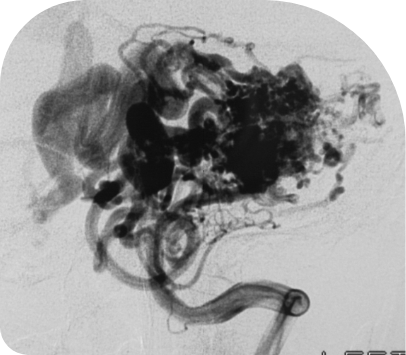Arteriovenous Malformations

What is an arteriovenous malformation (AVM)?
An arteriovenous malformation (AVM) is an abnormal tangle of arteries and veins that resembles a small bag of spaghetti.
The abnormal blood vessels in an AVM are fragile and can bleed easily. AVMs can occur anywhere in the body but are most dangerous in the brain and spinal cord.
The cause of AVMs is unclear. Most people with AVMs are born with them, but they may not be detected until they cause symptoms in adulthood. Around two hundred Australians are diagnosed with brain AVMs each year.

What are the symptoms of an arteriovenous malformation (AVM)?
Some people with AVMs will never have any symptoms, and an AVM of the brain may be an incidental finding when a brain scan is done for another reason (for example, for recurrent headaches or following a head injury).
If symptoms do occur, they are most likely to start between the ages of 10 and 40. Some women first experience symptoms during pregnancy. Symptoms of an AVM include headaches and seizures. However, in most cases, an AVM may be diagnosed for the first time when it causes a brain bleed.
What are the symptoms of a bleeding AVM?
An AVM could bleed into the brain (intracerebral haemorrhage), or into the fluid between the brain and its surrounding membrane (subarachnoid haemorrhage). The onset of symptoms is usually very abrupt and could include:
- Severe headache (with or without neck stiffness)
- Nausea and vomiting
- Confusion
- Weakness or numbness (usually on one side of the body)
- Seizures
- Loss of consciousness
A bleeding AVM is a life-threatening emergency and requires immediate treatment.

Are brain arteriovenous malformations (AVMs) serious?
An AVM in the brain is more serious than an AVM elsewhere in the body. A ruptured AVM could bleed into the brain (intracerebral haemorrhage), or it could bleed into the space between the brain and the membrane that surrounds it (subarachnoid haemorrhage). Either of these bleeds carries the risk of permanent disability or death.
In some cases, an AVM can put pressure on the brain and cause hydrocephalus (accumulation of fluid in the brain) or seizures. In young children, this could lead to developmental delay.
The risk of an AVM causing these problems depends on many factors. The Specialist at Macquarie Neurosurgery & Spine will perform a detailed assessment of the individual’s risk.
How is an AVM treated?
The Macquarie Neurosurgery & Spine team is highly specialised in the treatment of brain AVMs and has treated over 700 AVM patients. Our specialists are involved in ongoing AVM research aimed at developing new treatments for AVMs. This research is funded by the NHRMC. We take international evidence into account while formulating a personalised treatment plan for patients.
Individual factors to be considered, include:
- Whether the AVM has bled
- The likelihood of bleeding
- Whether the AVM is causing any other symptoms
- The location of the AVM
- The risks of treatment
- Patient’s general health
Specialists at Macquarie Neurosurgery & Spine are highly skilled in the following procedures for the management of AVMs:
- Microsurgery (Fine surgery done under a microscope, using tiny instruments)
- Radiosurgery by Gamma Knife (A less invasive approach, using highly targeted radiotherapy)
- Embolisation (Using x-ray guidance, the AVM is accessed via a blood vessel in the groin and blocked with a specialised glue)
